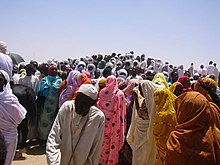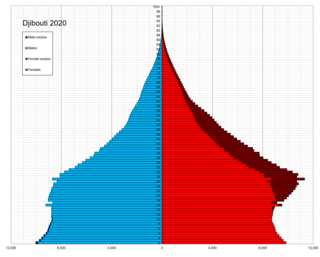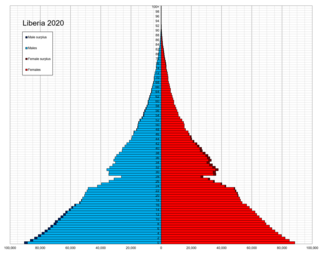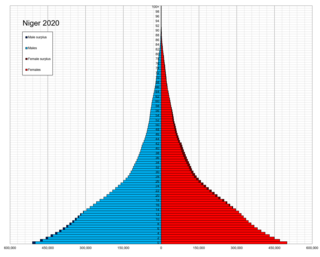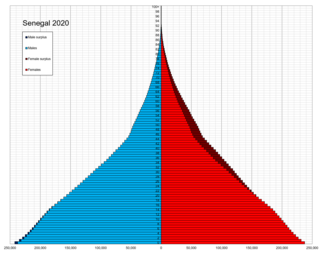This article needs additional citations for verification .(February 2008) |
| Demographics of Chad | |
|---|---|
 Population pyramid of Chad in 2020 | |
| Population | 17,963,211 (2022 est.) |
| Growth rate | 3.09% (2022 est.) |
| Birth rate | 40.45 births/1,000 population (2022 est.) |
| Death rate | 9.45 deaths/1,000 population (2022 est.) |
| Life expectancy | 59.15 years |
| • male | 57.32 years |
| • female | 61.06 years |
| Fertility rate | 5.46 children born/woman (2022 est.) |
| Infant mortality rate | 65.48 deaths/1,000 live births |
| Net migration rate | -0.13 migrant(s)/1,000 population (2022 est.) |
| Age structure | |
| 0–14 years | 47.43% |
| 65 and over | 2.43% |
| Sex ratio | |
| Total | 0.98 male(s)/female (2022 est.) |
| At birth | 1.04 male(s)/female |
| Under 15 | 1.02 male(s)/female |
| 65 and over | 0.69 male(s)/female |
| Nationality | |
| Nationality | Chadian |
| Language | |
| Official | French, Arabic |

The people of Chad speak more than 100 languages and divide themselves into many ethnic groups. However, language and ethnicity are not the same. Moreover, neither element can be tied to a particular physical type. [1]
Contents
- Population
- Vital statistics
- Fertility and births
- Religions
- Other demographic statistics
- Population 2
- Religions 2
- Age structure
- Median age
- Population growth rate
- Birth rate
- Death rate
- Net migration rate
- Total fertility rate
- Mother's mean age at first birth
- Dependency ratios
- Contraceptive prevalence rate
- Urbanization
- Sex ratio
- Life expectancy at birth
- HIV/AIDS
- Children under the age of 5 years underweight
- Major infectious diseases
- Child marriage
- Nationality
- Ethnic groups
- Religions 3
- Languages
- Literacy
- School life expectancy (primary to tertiary education)
- Notes
- References
Although the possession of a common language shows that its speakers have lived together and have a common history, peoples also change languages. This is particularly so in Chad, where the openness of the terrain, marginal rainfall, frequent drought and famine, and low population densities have encouraged physical and linguistic mobility. Slave raids among[ specify ] non-Muslim peoples, internal slave trade, and exports of captives northward from the ninth to the twentieth centuries also have resulted in language changes.
Anthropologists view ethnicity as being more than genetics. Like language, ethnicity implies a shared heritage, partly economic, where people of the same ethnic group may share a livelihood, and partly social, taking the form of shared ways of doing things and organizing relations among individuals and groups. Ethnicity also involves a cultural component made up of shared values and a common worldview. Like language, ethnicity is not immutable. Shared ways of doing things change over time and alter a group's perception of its own identity.
Not only do the social aspects of ethnic identity change but the biological composition (or gene pool) also may change over time. Although most ethnic groups emphasize intermarriage, people are often proscribed from seeking partners among close relatives—a prohibition that promotes biological variation. In all groups, the departure of some individuals or groups and the integration of others also changes the biological component.
The Chadian government has avoided official recognition of ethnicity. With the exception of a few surveys conducted shortly after independence, little data were available on this important aspect of Chadian society. Nonetheless, ethnic identity was a significant component of life in Chad.
The peoples of Chad carry significant ancestry from Eastern, Central, Western, and Northern Africa. [2]
Chad's languages fall into ten major groups, each of which belongs to either the Nilo-Saharan, Afro-Asiatic, or Niger–Congo language family. These represent three of the four major language families in Africa; only the Khoisan languages of southern Africa are not represented. The presence of such different languages suggests that the Lake Chad Basin may have been an important point of dispersal in ancient times.

